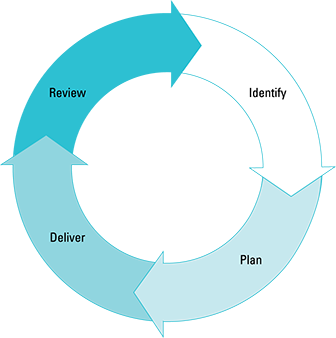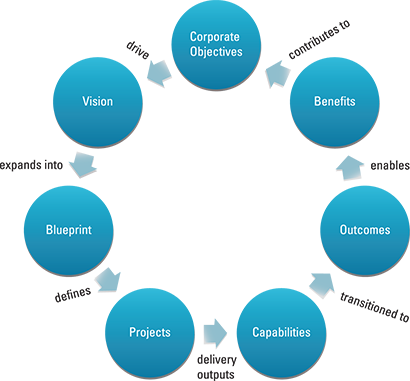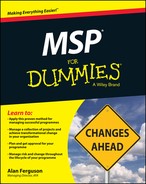Chapter 16
Reaping the Benefits: Measuring Your Outcomes
In This Chapter
![]() Following a cycle for realizing benefits
Following a cycle for realizing benefits
![]() Reviewing your benefits
Reviewing your benefits
![]() Getting an all-round picture of benefits
Getting an all-round picture of benefits
Benefits management is about a lot more than modelling benefits, which I cover in Chapter 15. After you create the benefits model and associated documentation in Defining a Programme, you need to realize them and manage that realization.
In this chapter I cover the benefits life-cycle: the simple process for making benefits happen and measuring them. This aspect includes a look at the relationship between benefits and corporate objectives, which is another way of giving you an insight into the cycle you're following. I also discuss the nature of the benefit reviews that you need to commission at various points throughout your programme. Also, benefits management is such a large subject that you can pick up useful knowledge by considering them from different viewpoints, including the areas of responsibilities and the focuses of key roles.
Turning to the Benefits Cycle
When MSP was refreshed in 2011, I was keen to make benefits management as accessible as possible. One thing I pressed hard for, and was glad to see included in the MSP method, was a simple, understandable benefits cycle. This cycle is shown in Figure 16-1.

Copyright © AXELOS Limited 2011 Reproduced under licence from AXELOS
Figure 16-1: The steps in the benefits management cycle.
Pedalling through the benefits cycle process
This cycle is how you get things done in a measured way. Here are the steps of the benefits management process:
- Identify the benefits. This step is another name for modelling the benefits and includes identifying, categorising and validating the benefits. It finishes around the time you have a Benefits Map that everyone is happy with (flip to Chapter 15 for more on Benefits Maps).
- Plan the benefits. You're planning benefits management as you complete the benefits documentation. But that planning continues as you link the benefits plans to the other plans that you're creating.
 First time round this step is in Defining a Programme, but you probably repeat it at each tranche boundary.
First time round this step is in Defining a Programme, but you probably repeat it at each tranche boundary. - Deliver the benefits. You won't be surprised to hear that delivering benefits happens during the Realizing the Benefits process, which I cover in Chapter 20.
- Review the benefits. The final step is to carry out benefits reviews, mostly as part of managing your tranches. You can find more about that in Chapter 18 and in the later section in this chapter, ‘Carrying Out Benefits Reviews’.
Relating the programme and corporate objectives
A useful way of understanding the benefits cycle is to look at the relationship between benefits and other elements of programme management, such as corporate objectives. I show these relationships in Figure 16-2.

Figure 16-2: Programmes and corporate objectives.
Here are the details of Figure 16-2:
- Corporate objectives to Vision. Corporate objectives drive the development of the programme Vision.
- Vision to Blueprint: The Vision is expanded into a Blueprint (a model of the future organization, sometimes called the ‘to-be’ state, which I describe in Chapter 6).
 Blueprint to outputs. The Blueprint helps you to define what projects you need to create the outputs. You do so by identifying gaps in the Blueprint between the ‘as is’ and ‘to be’ states, and analysing which outputs are needed to help fill that gap.
Blueprint to outputs. The Blueprint helps you to define what projects you need to create the outputs. You do so by identifying gaps in the Blueprint between the ‘as is’ and ‘to be’ states, and analysing which outputs are needed to help fill that gap.- Outputs to capabilities. Projects deliver outputs that create capabilities; or to be more precise, projects deliver outputs that are a project-orientated view of the deliverables from a project. Although in business as usual these outputs are regarded as capabilities, in most cases several outputs come together to create a single capability.
- Capabilities to outcomes. Capabilities are transformed into outcomes; or to put it another way, the capabilities are exploited in order to achieve outcomes.
- Outcomes to benefits. Outcomes enable the realization of benefits, because a benefit is how you measure the achievement of an outcome.
- Benefits to corporate objectives. As the benefits are being achieved, they contribute to the achievement of corporate objectives. Take another look at Figure 16-2 to note how benefits relate to the Vision. The benefits are how you demonstrate that you've achieved the Vision.
Carrying Out Benefits Reviews
A programme can all too easily get lost in project management, because people, from the lower levels in the programme up to the Senior Responsible Owner (SRO), like to focus on the schedule of projects. But the programme doesn't exist to deliver outputs; its purpose is to deliver benefits.
So your programme needs to put in place a series of benefits reviews that have the rigour and independence to look out for whether the benefits are being achieved in accordance with the Benefits Realization Plan (which I introduce in Chapter 15).
Staying on track: Programme benefit reviews
A programme benefit review helps ensure that the benefits realization remains on track. You typically hold it at the end of each tranche, although it can be time- or event-driven. The review covers historic benefits, but it also needs to look forward to see whether the expectation of future benefits delivery is realistic. The reviewers take soundings from all relevant stakeholders. They check the validity of benefits and the value that they've achieved against the perception of stakeholders that the benefits are being achieved and against the environment, which of course can change significantly since the programme was first planned.
Setting objectives for the review
Here's a set of objectives for a benefits review. I use these frequently when I'm carrying out audits on behalf of programmes: they're a really helpful starting point for a review. You can see that these objectives focus on benefits and pay hardly any attention to projects:
- Assess and update Benefit Profiles and the Benefits Realization Plan:
- Ensure that benefits remain achievable.
- Check the benefits still align with the programme and organizational objectives.
- Inform stakeholders of progress:
- Identify any further potential for benefits.
- Assess performance of changed business operations against original performance.
- Assess benefits achieved against Profiles.
- Review effectiveness of benefits management:
- Develop improved methods.
- Improve definition of benefits.
- Improve understanding of capability to deliver.
Scheduling programme benefit reviews
Although a benefit review can happen at any time, common practice is to carry them out at the end of tranches and to link project reviews, benefit reviews and programme (tranche) reviews together in an integrated set of reviews that inform planning for the next tranche.
Viewing Benefits From Different Angles
As you may have gathered from the fact that I take two chapters to do justice to benefits, it's a huge subject. Therefore, I think that you may appreciate the opportunity to consider benefits from different viewpoints. Think of it as like walking around a large sculpture and pausing here and there to consider it. I provide a few ideas in this section, including through the lens of the duties of the people and groups crucial to benefits management.
Quantifying benefits
You may find looking at benefits management from the point of view of quantifying benefits helpful. Ideally, you want to quantify and measure benefits in monetary terms, which certainly makes the process more straightforward. But if you can't quantify benefits in monetary terms, you need to do so numerically.
For example, if you want to measure customer satisfaction, you can carry out a customer survey. But a customer survey doesn't measure customer satisfaction; it measures responses to the survey. The responses to that survey may be an indicator of customer satisfaction.
You do, however, need to expend additional effort on the assessment of the indirect benefits, as does the organization on agreeing to the model that links the indicators to those indirect benefits.
Whatever the benefits, you have to baseline them before the capabilities are delivered. (See Chapter 12 for more on configuration management).
Identifying benefits
Here's a chance to look at the fundamental set of links from the viewpoint of the identification of benefits:
 Outcomes (the quantification of improvements) are first identified as early as possible, possibly in the Programme Mandate and certainly by the time of the Programme Brief.
Outcomes (the quantification of improvements) are first identified as early as possible, possibly in the Programme Mandate and certainly by the time of the Programme Brief.- You then expand benefits into the Vision, which you turn subsequently into the Blueprint.
- You almost certainly need to use a Benefits Map to show the relationship between benefits.
Stepping up to the plate: Ownership, responsibilities and accountabilities
You're trying to make sure that the ownership of benefits is spread out into business as usual. You don't want that ownership focused on one post at the heart of the programme. Here are some ideas on who is responsible for what, to help you get those benefits jobs shared out:
- The SRO owns the overall set of benefits.
- The SRO appoints an owner for each benefit (probably via the Business Change Managers).
- Other responsibilities are spread across the Programme Management Team.
Table 16-1 has more detail on benefits responsibilities.
Table 16-1 Responsibilities for Benefits Management
|
Benefits Management Process |
Accountabilities and Responsibilities |
|
Identifying and defining |
Business Change Manager(s)Business Area ManagersAgreed with SRO |
|
Planning, monitoring and tracking |
Programme OfficeProgramme Manager's responsibility |
|
Realization |
Specific Business Area Managers working with Business Change Manager(s) |
|
Assessment |
Individuals with good knowledge of target business areas, but not directly involved in the programme |
Paying attention to areas of focus for benefits
I cover the programme roles in general in Chapter 9, but here I run quickly through the areas of responsibilities as they relate to benefits.
Senior Responsible Owner
The SRO is the senior individual accountable for the success of the programme who's responsible for the following:
- Reporting to the Sponsoring Group on the delivery of the programme benefits as described in the Benefit Profiles.
- Ensuring that the programme and business areas affected maintain a focus on benefits delivery.
- Ensuring that the Benefits Management Strategy is created, adjusted, improved and enforced.
- Maintaining focus on business performance sustainability during transition. If the business performance drops off, that's a dis-benefit not being managed.
- Chairing benefit reviews involving relevant stakeholders, business managers and possibly internal auditors.
- Liaising with the Sponsoring Group on the validation of all benefits claimed by the programme.
- Authorising benefits achievements.
Programme Manager
The Programme Manager runs the programme, day-to-day, and is responsible for:
- Developing the Benefits Management Strategy on behalf of the SRO with the Business Change Managers and relevant stakeholders from the affected business areas.
- Developing the Benefits Realization Plan in conjunction with the Business Change Managers, relevant stakeholders and members of the project teams.
- Ensuring that the delivery of capability is aligned to maximise the realization of benefits.
- Initiating benefit reviews as part of the Benefits Realization Plan or in response to any other triggers.
Business Change Managers
Business Change Managers bed down the changes in their parts of the business and are responsible for:
- Identifying and quantifying the benefits with the support of relevant stakeholders, the Programme Manager and members of the project teams.
- Delivering particular benefits as profiled; this extends to ensuring that commitments and actions attributed to operational areas are delivered.
- Providing information to support the creation and delivery of the Benefits Realization Plan.
- Developing and maintaining Benefit Profiles and ensuring no double counting of benefits.
- Maintaining engagement with key individuals responsible for benefits delivery within operations.
- Setting business performance deviation levels and early warning indicators to support realizing the benefits.
- Initiating benefit reviews after the programme is closed.
Programme Office
The Programme Office looks after the administration of the programme and is responsible for:
- Monitoring the progress of benefits realization against plans.
- Gathering information for benefits reviews.
- Producing performance reports on how benefits management is going, as defined by the Programme Manager.
- Maintaining benefits information under change control and maintaining audit trails of changes.

 If you're thinking of skipping the reviews, think again. Linking benefits reviews to tranches effectively places a stake in the ground before the next tranche moves forwards. If the programme is badly off-track the benefits review can be the catalyst for closing the programme. But if you follow my advice in this book, your programme is sure to be much more successful than that.
If you're thinking of skipping the reviews, think again. Linking benefits reviews to tranches effectively places a stake in the ground before the next tranche moves forwards. If the programme is badly off-track the benefits review can be the catalyst for closing the programme. But if you follow my advice in this book, your programme is sure to be much more successful than that.